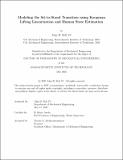| dc.description.abstract | The Sit-to-Stand (STS) transition is one of the most dangerous daily activities for the elderly population, as it is one of the situations in which falls occur most often. Despite its risks, STS dynamics remain poorly understood, and current STS assistance devices fail to utilize knowledge of STS dynamics to effect their support. This thesis presents contributions to the dynamic modeling of STS and to human-robot collaboration for improving robotic assistance of STS. To coherently capture the multi-phase nature of STS, lifting linearization, a dynamic modeling methodology inspired by Koopman operator theory, to subsume segmented local dynamics in a globally linear dynamic model. A novel class of lifting linearization basis functions, termed “State-Membership Product (SMP)” observables, enables both the seamless blending of local dynamics into a global model, and the direct extraction of phase-specific behaviors from the global model. It is shown that an SMP-Koopman linear model tuned to published data of STS experiments is capable of reproducing the multi-phase STS dynamics with a single linear model. Building on this framework, STS is additionally modeled as a lifted linear feedback control system, composed of an SMP-Koopman-based open-loop biomechanical model of the human body and a linear quadratic regulator (LQR) which guides the body to stand up. The LQR controller, tuned to replicate STS motion, guides the human body model through the phases of STS without explicit phase-switches, improving system robustness. To enhance human-robot collaboration in STS assistance, a framework for estimating patient cooperativeness is also introduced, leveraging a simplified dynamic model and an Extended Kalman Filter. By analyzing a human’s initial response to applied physical and verbal cues, the estimation framework assesses willingness to engage in assisted STS. Together, these contributions advance both the modeling and estimation of STS, offering insights crucial for the development of safe, effective robotic assistance. | |
